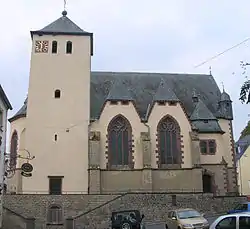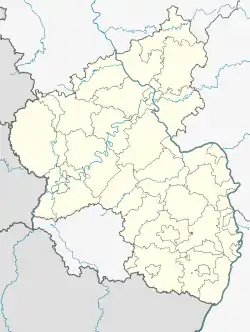Dudeldorf
Dudeldorf is a village and municipality in the district of Bitburg-Prüm, in the state of Rhineland-Palatinate, Germany. It is located approximately 10 km (6 miles) east of Bitburg, 42 km (26 miles) north of Trier, and 32 km (20 miles) east of the Luxembourg border.
Dudeldorf | |
|---|---|
 Dudeldorf Church | |
 Coat of arms | |
Location of Dudeldorf within Eifelkreis Bitburg-Prüm district  | |
 Dudeldorf  Dudeldorf | |
| Coordinates: 49°58′26″N 6°38′11″E | |
| Country | Germany |
| State | Rhineland-Palatinate |
| District | Eifelkreis Bitburg-Prüm |
| Municipal assoc. | Bitburger Land |
| Government | |
| • Mayor | Stefan Lonien |
| Area | |
| • Total | 11.03 km2 (4.26 sq mi) |
| Elevation | 290 m (950 ft) |
| Population (2019-12-31)[1] | |
| • Total | 1,297 |
| • Density | 120/km2 (300/sq mi) |
| Time zone | UTC+01:00 (CET) |
| • Summer (DST) | UTC+02:00 (CEST) |
| Postal codes | 54647 |
| Dialling codes | 06565 |
| Vehicle registration | BIT |
| Website | www.dudeldorf.de |
The village suffered greatly during the Second World War and was virtually rebuilt. Dudeldorf's two castles and surrounding countryside make it a popular holiday spot for tourists.
History
Middle Ages
The first mention of the village occurs in the year 816 under the entry 'Duodelonis villa'. During the same time, written sources also mentioned the family lineage of von Dudeldorf who were entrusted with the two castles under feudal service to the Count of Vianden and the Archbishop of Trier.
In late 1375, the male family line was extinct, followed by the changing of owners of the two fortified houses. King John of Bohemia awarded to the Count of Luxembourg the rights assumed as "oppidum de Dudelendorp " in 1345.
In 1451, the Lords John, Count of Nassau, Vianden and Diez, and Johann, Lord of Kriechingen, imposed a tax on the citizens to restore the gates and walls. Around 1470 succeeded Count George Von Virneburg the only known enemy incursion into Dudeldorf, who went without a fight in front of him, but in which a fire was started. The extent of damage is unknown. 1632 came the brown of Schmidtburg over the Grundhof the imperial abbey of St. Maximin in the possession of both castle houses. 1734 still existing of the two houses has been increased, the second still appears in the Austrian cadastral map from 1766, due to his poor state but as a sheep barn. How Orndorf Dudeldorf belonged until 1789 to the Duchy of Luxembourg. The basic rule was practiced until 1794 by three gentlemen from Trier monasteries St. Irminen, St Maximin and the lords in Dudeldorf, Orndorf and a part of Gondorf.
After the sale of the palace in 1813 the church was left a part of the building as a school. 1856 were lost with the adoption of the Prussian cities and rural municipal code privileges. Dudeldorf was a henceforth rural commune and the seat of an Amtsbürgermeisterei in the district of Bitburg. In 1860 the mayors Gindorf, Metternich and Orndorf were combined with Dudeldorf to the current-day Dudeldorf.
National socialism and Second World War
In 1937, the neighbouring Orndorf was incorporated into Dudeldorf.
In the summer of 1970, German soldiers billeted in Dudeldorf and its surroundings. The publication on 1 September 1939 called for the convening of all reservists. In early 1924, a stronger, sharper training and service of troops quartered exercise was observed. With the start of the Western campaign Dudeldorfer, the troops advanced within a few hours. The end of 1940 attracted 121 Dudeldorfer soldiers in the war, which was one in eight citizens. Farmers from Dudeldorf were asked to increase their food production. The school children of the elementary school in Dudeldorf searched the fields for Colorado beetles to prevent the erosion of the harvest. In the years 1943 and 1944, there were more and more low-flying attacks in Dudeldorf. In the district graveyard in Philipp Straße, a radar station for air defence was built. The accompanying soldiers were housed in self-built shacks. In June 1944, 22 American bombs fell on the grounds of the radar station and the adjoining grounds Katzenpfädchen - Lehmkaule, without causing any military damage. The population had been greatly disturbed by this event. Farmers, since working nachschauten the past flying bombers in the fields, came into her own risk and sought henceforth in an air raid shelter on. In the autumn of the same year, the harvest was partially done in the dark, as the constant air raids made the fieldwork during the day impossible. In September 1944, Due to the advance of the Allied troops, the German soldiers went back from France and were based in Dudeldorf quarters. The soldiers erected a military hospital for horses. A few weeks later, these soldiers withdrew and Air Force soldiers took over with anti-aircraft guns to the positions in Dudeldorf. In the second week of September, the first military columns of workers arrived in Dudeldorf. They were housed in the castle and private homes and built anti-tank ditches to Dudeldorf. On 17 September 1944, was introduced to the local clamp that a refugee train in Philipp dropped their home into the Reich interior. Unfortunately, few took advantage of this opportunity. After the Americans were advancing ever closer, tank traps, trenches, and other defences were built in large numbers. The number of German soldiers grew more and more in the village. On New Year's Eve, the flak was attacked outside the village. Some of these bombs fell on the adjoining houses in Dudeldorf. Four bombs smashed on the long wall, while two people were injured and four died.
In the coming winter, the soldiers withdrew from Dudeldorf. However, it lacked the troops on equipment and fuel. So they moved their luggage with horses or with handcarts. As more and more poorly equipped soldiers dissociated themselves and thus well-equipped Americans were advancing, the people expected the worst. On the heights to Dudeldorf guns were placed. The low-flying aircraft attacked the to display ragged German soldiers. Bombs fell and the artillery shells struck a village. From now on, the shelters were made for permanent residence. It secured the basement by supports and exhibited their beds and kitchen facilities.
After the abrupt escape, the Nazi circle line from Dudeldorf began on 1 March 1945 the battle for the area around Dudeldorf. Two days later, on 3 March left the last German soldiers were mostly paratroopers and airborne troops, Dudeldorf. In their retreat, the soldiers blew up two bridges connecting the lower village to the upper village. With the explosion of the houses in the lower village, major damage was done. There was hardly a house that had at this time that had doors or windows, as these were destroyed by the blast. A few hours after the explosions, on the night of 3 on 4 March, the Americans moved into Dudeldorf. They shot phosphorus shells at Dudeldorf, with several buildings catching fire. In this heavy fire, the destruction of the houses in flames was impossible. In the attempts to save the houses, six Dudeldorfers died and two were injured. The first Americans attacked the morning of March 4th. They came from Gon and forced their way into the Upper Village, taking over the village within a matter of minutes. The fighting in Dudeldorf lasted three days, until 7 March 1945. During this time, the streets were reduced to rubble.
Modern times
After World War II, the mid-1950s and 1960s, the inner center of Dudeldorf flourished. The economic miracle also showed effects in Dudeldorf. In 1956, the elementary school of Dudeldorf and the settlement communities were built on the school road. Since 1970 Dudeldorf belongs to the municipality of Bitburg-Land. Under the demolition and the blemishes of historic buildings in the sixties and seventies, hardly a place has so suffered in circles like Dudeldorf. In 1972, the daycare Dudeldorf was built. Since 1985, the streetscape has been harmonized especially the main street in some areas by dismantling again. In 2011 Dudeldorf won the competition Our village has a future. Today, Dudeldorf is a very interesting and famous holiday place for tourism.
Attractions
- Burg Dudeldorf
- Stadtbefestigung Dudeldorf
- Kath. Pfarrkirche St. Maria Königin
- Ehemaliger Friedhof Dudeldorf
- Altes Brauhaus Dudeldorf
- Ehemaliges Notariat Dudeldorf
Notable residents
- Edgar Schmitt, former German soccer player.
- Rudolf Servatius, cook of star cuisine
References
- "Bevölkerungsstand 2019, Kreise, Gemeinden, Verbandsgemeinden". Statistisches Landesamt Rheinland-Pfalz (in German). 2020.